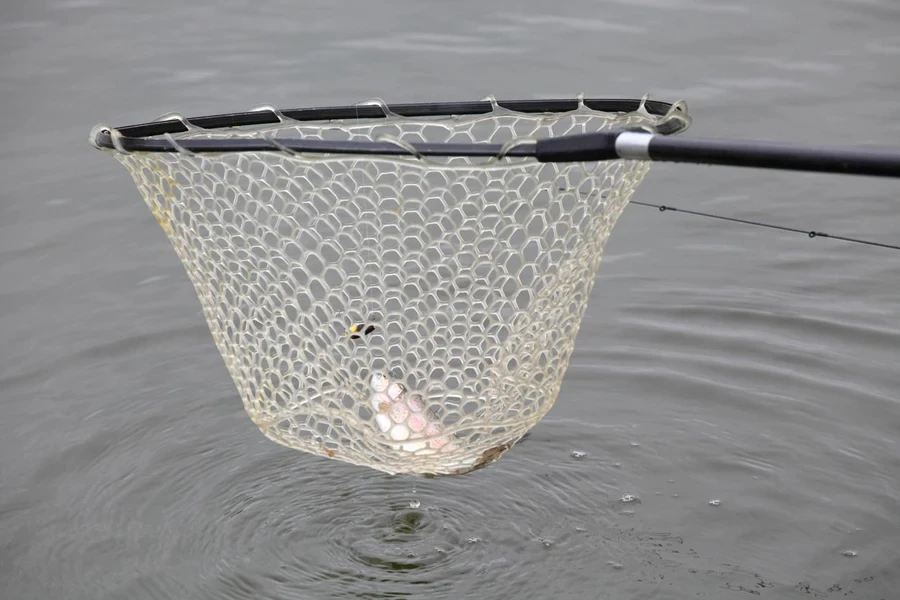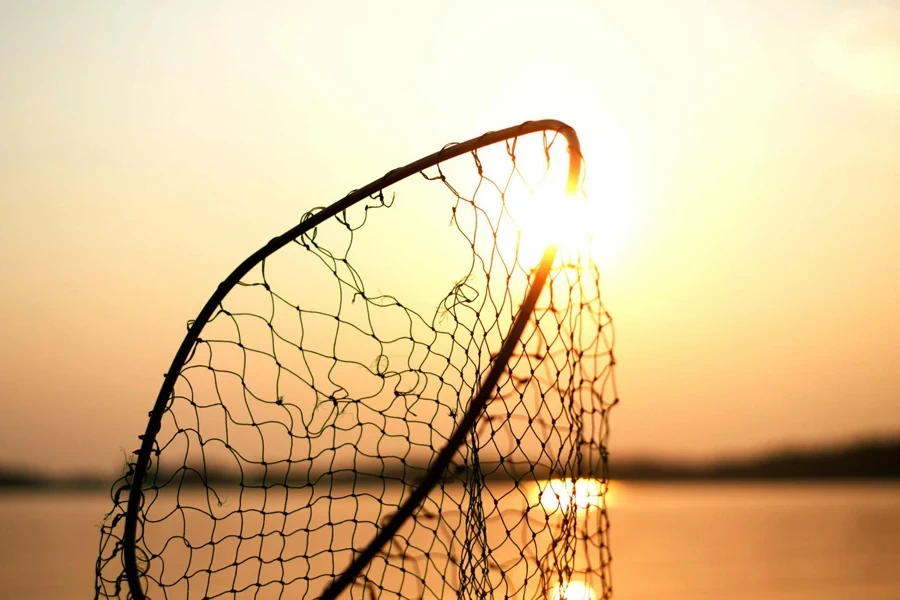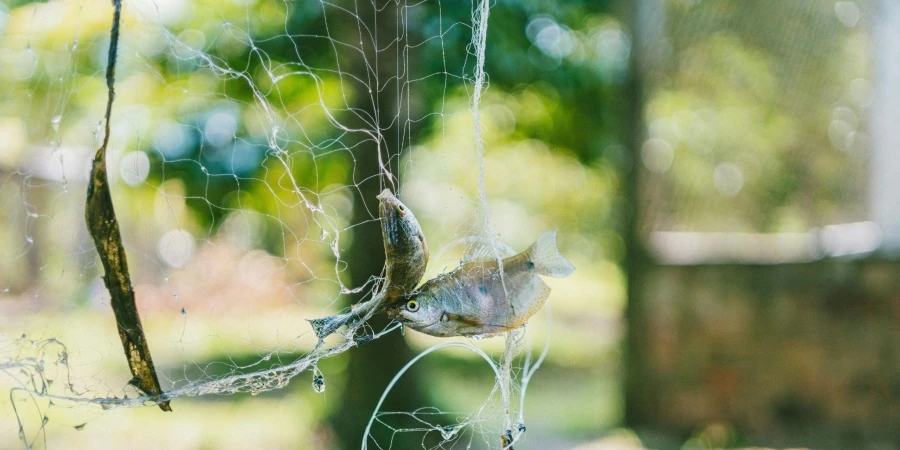Table of Contents
● Introduction
● Types of fishing nets and their usage
● Fishing net market overview for 2025
● Key factors when selecting a fishing net
● Top fishing nets for 2025
● Conclusion
Introduction
Picking the appropriate fishing net is essential for achieving effective and efficient fishing outcomes; this becomes even more critical with the emergence of new designs and materials in 2025. A well-selected net has the potential to enhance handling ease and guarantee fish welfare, a crucial aspect given the rising emphasis on conservation-focused approaches. Whether it’s heavy-duty models tailored for substantial catches or convenient foldable choices for distant fishing expeditions, the decision on which net to use greatly impacts overall performance. Knowing about the types of fishing nets and how they work in different fishing situations is key for fishermen to have the proper gear for any fishing scenario.
Types of fishing nets and their usage

Landing nets for different fish sizes
Landing fishing nets are crucial for fishermen as their efficiency varies based on the size of the fish being pursued. Using nets with tight mesh and shallow hoops is best when going after small freshwater fish such as trout or bass. These nets are ideal to prevent fish from slipping through and minimize harm during catch-and-release scenarios. On the other hand, when targeting larger freshwater or smaller saltwater species, opting for nets with larger hoops and stronger mesh is recommended. This ensures that the net can handle heavier catches while maintaining durability over time.
Folding and retractable nets for mobility
Anglers who want to move easily find folding and retractable nets very convenient to use while fishing in remote locations or during long hikes. They can easily collapse for transportation purposes, and the telescopic handles provide versatility. The nets are made from durable materials to handle medium-sized catches without compromising strength. Innovations such as quick-release mechanisms enable deployment while striking a balance between portability and effectiveness.
Specialty nets for kayak fishing
Fishing from a kayak requires small and tough nets to handle tricky spots and tough conditions effectively. Specific kayak nets usually come with handles and collapsible structures for convenient storage and easy use. Crafted from materials that are resistant to corrosion, these nets can withstand harsh elements, like saltwater and rocky terrains. Their fish-friendly mesh and deeper hoops securely cradle medium-sized catches, making them a must-have for dedicated kayak anglers.
Fishing net market overview for 2025

Current trends and growth in the fishing gear market
The fishing equipment industry is projected to witness growth by 2025 with a particular emphasis on the nets segment. This is due to various factors such as the increasing worldwide interest in recreational fishing and the growing emphasis on sustainable fishing practices for environmental conservation. Also, advancements in fishing gear technology innovation is driving this growth momentum. There is anticipated growth in the demand for fishing nets tailored to different fishing settings ranging from small streams to expansive oceans. Major participants in the industry are concentrating their efforts on creating nets that provide enhanced longevity and user-friendliness while incorporating eco-friendly attributes.
Recent market forecasts indicate that the fishing equipment sector is expected to experience a growth rate of 4.5% compounded annually until 2025. This expansion is driven by the uptick in recreational and commercial fishing endeavors in different areas. Additionally, there’s a growing preference for environmentally friendly and sustainable fishing gear as more individuals and companies are concerned about the impact of their actions on the environment. Fishing nets made from eco materials like rubber-coated mesh are becoming more popular due to their minimal impact on marine life ecosystems. The market is also evolving with the use of lightweight and corrosion-resistant materials like carbon fiber to provide stronger and more sustainable options for fishing activities in both leisure and business settings.
Technological innovations driving the market
The fishing net industry in 2025 is being greatly influenced by progressions and innovations that are revolutionizing how nets are constructed and utilized to enhance their durability and effectiveness in saltwater environments. One noteworthy development is the use of cutting-edge materials like carbon fiber and aerospace-grade aluminum that offer superior strength without compromising weight requirements, making it ideal for withstanding corrosion in saltwater conditions. Take, for instance, the Bubba Carbon Fiber Net, which epitomizes this advancement by providing a balance of robustness and lightweight construction suited for capturing large saltwater fish while enduring the challenges of marine settings.
One significant advancement involves enhancing the design of fishing nets to prioritize the well-being of fish and conservation efforts. The rising popularity of fishing practices has created a need for nets that lessen stress and harm to fish. Rubber-coated mesh nets have gained favor due to their ability to decrease tangling and be more gentle towards fish. These nets encourage catch and release methods. In addition, retractable fishing nets are being improved to be more compact and easy to use, enabling better mobility and convenient storage without sacrificing effectiveness. These advancements in technology are not just pushing the industry ahead but also adapting to the changing demands of contemporary fishermen.
Key factors when selecting a fishing net

The dimensions and weight of a fishing net are factors in deciding how well it works in various fishing settings. Smaller and lighter nets are perfect for fishing from the shore as they’re easy to carry and move around easily—especially when catching smaller fish such as trout or bass. On the other hand, when fishing from a boat, bigger nets with wider hoops are usually needed to handle larger species found in deeper waters. When kayak fishing in spaces with limited room for gear storage, it’s essential to have compact and foldable nets that are strong yet easy to carry. These nets allow anglers to manage catches without adding extra weight or getting tired during long fishing trips.
Lately, in the angling world, there’s been attention on looking after fish and protecting them for the future. Rubber-coated nets have become popular because they help to be gentle when catching and releasing fish. These nets have a surface that lowers the chances of hurting the fish scales or fins, which is why many anglers who care about conservation prefer using them. Using these nets also aids in preventing hooks from getting tangled up, which saves time and decreases annoyance during a day of fishing activities. This is particularly crucial when dealing with smaller fish that are prone to causing injuries.
Many of the fishing nets are crafted with features that are considerate of fish wellbeing; for example, deep and flat-bottomed structures provide a cozy resting spot for the fish inside to reduce stress and avoid harm in the process. The focus is on safeguarding the catch and meeting the increased call for eco-friendly fishing methods. These innovations aim to allow anglers to pursue their hobby while also playing a role in conserving fish stocks for generations.
Top fishing nets for 2025

High-strength carbon fiber models
Carbon fiber fishing nets have become popular due to their strength-to-weight ratio, which makes them perfect for catching big fish in various water settings like lakes and oceans. These nets are easy to handle because of their weight and also boast resistance against corrosion and durability. These qualities enable fishermen to fish for long periods without getting tired. Equipped with handles that provide better grip and reliability even in challenging situations, carbon fiber nets are the top choice for dedicated anglers as they offer consistent performance over time, even in tough conditions.
Kayak fishing nets
Kayak fishing nets are made to be compact and easy to handle while kayaking, and their foldable handles fit well in limited kayak space. These nets are lightweight and sturdy, which allows anglers to catch fish with one hand while navigating the kayak smoothly. Crafted from materials to corrosion for durability and practicality, kayak nets are a great choice for anglers in freshwater or saltwater settings due to their efficiency and space-saving design.
Rubber-coated nets for fish care
Rubber-coated fishing nets have become popular for catch-and-release fishing because they help protect fish by reducing injuries. They prevent hooks from getting tangled and minimize harm to the fish scales and fins. This makes them a compassionate choice for anglers who care about the well-being of fish. These nets have flat bottoms to lessen the stress on the fish while emphasizing conservation and sustainability. They offer a sensible option for fishermen committed to preserving fish populations.
Conclusion

Choosing the ideal fishing net is crucial to enhance productivity and promote environmental responsibility as technology progresses in 2025. Deciding between a durable carbon fiber net for fishing activities or a collapsible option for easy transport should be based on individual requirements and surroundings. In an era where sustainability is paramount in product design choices, we are shifting towards eco-friendly materials such as rubber-coated mesh to revolutionize fish conservation practices in the future. There will be an increase in the need for lasting and eco-friendly fishing equipment. This trend highlights the importance of efficiency and sustainability in the changing fishing gear market.




